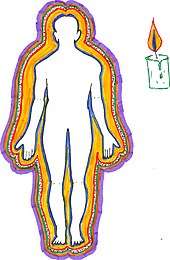Kosha
A kosha (also kosa; Sanskrit कोश, IAST: kośa), usually rendered "sheath", is a covering of the Atman, or Self according to Vedantic philosophy. There are five koshas, and they are often visualised as the layers of an onion in the subtle body.[1]
Origins
The five sheaths summarised with the term Panchakosha are described in the Taittiriya Upanishad (2.1-5).[2][3] From gross to fine they are:
- Annamaya kosha, "food" sheath (Anna)[3]
- Pranamaya kosha, "energy" sheath (Prana)[3]
- Manomaya kosha "mind" sheath (Manas)[3]
- Vijñānamaya kosha, "discernment" sheath (Vijnana)[3]
- Anandamaya kosha, "bliss" sheath (Ananda)[3]
According to Vedanta the wise person, being aware of the subtle influences of the five elements within each kosha, ever discerns the Self amidst appearances.
The five sheaths

Annamaya kosha
This is the sheath of the physical self, the grossest of the five koshas, named from the fact that it is nourished by food. Living through this layer humans identify themselves with a mass of skin, flesh, fat, bones, and feces, while the human of discrimination knows oneself, the only reality that there is, as distinct from the body. The physical body is formed of the essence of food. Birth and death are the attributes of the Annamaya kosha.
Pranamaya kosha
Pranamaya means composed of prana, the vital principle, the force that vitalizes and holds together the body and the mind. It pervades the whole organism, its one physical manifestation is the breath. As long as this vital principle exists in the organisms, life continues. Coupled with the five organs of action it forms the vital sheath. In the Vivekachudamani it is a modification of vayu or air, it enters into and comes out of the body.
Manomaya kosha
Manomaya means composed of manas or mind. The mind, along with the five sensory organs, is said to constitute the manomaya kosa. The manomaya kosa, or "mind-sheath" is said more truly to approximate to personhood than annamaya kosa and pranamaya kosha. It is the cause of diversity, of I and mine. Adi Shankara likens it to clouds that are brought in by the wind and again driven away by the same agency. Similarly, man's bondage is caused by the mind, and liberation, too, is caused by that alone.
Vijñānamaya kosha
Vijñānamaya means composed of vijñāna, or intellect, the faculty which discriminates, determines or wills. Chattampi Swamikal defines vijñānamaya as the combination of intellect and the five sense organs. It is the sheath composed of more intellection, associated with the organs of perception. Sankara holds that the buddhi, with its modifications and the organs of knowledge, form the cause of man's transmigration. This knowledge sheath, which seems to be followed by a reflection of the power of the cit, is a modification of prakrti. It is endowed with the function of knowledge and identifies itself with the body, organs etc.
This knowledge sheath cannot be the supreme self for the following reasons;
- It is subject to change.
- It is insentient.
- It is a limited thing.
- It is not constantly present.
Anandamaya kosha
Anandamaya means composed of ananda, or bliss; it is the subtlest of the five koshas. In the Upanishads the sheath is known also as the causal body. In deep sleep, when the mind and senses cease functioning, it still stands between the finite world and the self. Anandamaya, or that which is composed of supreme bliss, is regarded as the innermost of all. The bliss sheath normally has its fullest play during deep sleep: while in the dreaming and wakeful states, it has only a partial manifestation. The blissful sheath (anandamaya kosha) is a reflection of the Atman which is truth, beauty, bliss absolute.
The following entry is for the utility of Hindu aspirants who are familiar with Panchakosha:
Just as each of the five elements (earth, water, fire, air, and ether) appear in corresponding subtlety among each of the five senses so too the intellect cognizes ever subtler causes and effects at play through each of the five sheaths.
For example, the annamayakosha, the coarsest sheath, is based in the earth element, which is guarded by Ganesha, while the very subtlest sheath Anandamaya is based in the quanta/ether element, and is guarded by a black disc of utter darkness over the sun, which can be removed only by Ganesha.
Awareness of that reflection of atman/self within the most subtle sheath, Anandamayakosha, however, is but the foundation for discerning that which the elements, energies, senses, and kosha serve. To that end, one re-examines the components of the five koshas in daily devotional meditation after recitation of twenty-one OM, viz, one OM per each of the five elements, the five pranas, the five indriyas, and the five kosha, equaling twenty OM, then a twenty-first OM is offered for the ineffable, such that a spiritual discernment of ever-increasing subtlety arises in the purified intellect, alaya nirvijnana, the womb of the tathāgata, wherein silence ensues and clarity blossoms.
See also
- Advaita Vedanta
- Chakra
- Guna
- Kundalini
- Mandukya Upanishad
- Three bodies
References
- Roeser, Robert W. (2005). An introduction to Hindu India's contemplative psychological perspective on motivation, self, and development (PDF) (pdf ed.). p. 15. Retrieved 25 June 2015.
- David Frawley, Yoga and the Sacred Fire: Self-Realization and Planetary Transformation, p.288
- Mallinson & Singleton 2017, p. 184.
Sources
- Mallinson, James; Singleton, Mark (2017). Roots of Yoga. Penguin Books. ISBN 978-0-241-25304-5. OCLC 928480104.CS1 maint: ref=harv (link)

